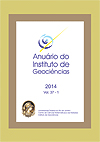Environmental Compartments of Arade River Estuary, South of Portugal, Based on Distribution and Ecology of Foraminifera
DOI:
https://doi.org/10.11137/2014_2_60_74Keywords:
Foraminifera, Mesotidal estuary, Estuarine compartments.Abstract
In September 2010 five sediment samples were collected along the estuary of the Arade River aimed to identify environmental compartments based on the distribution of foraminifera species and their relationship with physic-chemical, sedimentological and geochemistry parameters. In the estuary were identified 39 foraminifera species, from wich 31 were calcareous species and 8 agglutinated species that which showed the great species richness values in Arade Estuary. The dominant species were Ammonia tepida and Haynesina germanica that were identified in all sample stations. The mouth of estuary showed the highest values of richness of specimens (31) and diversity (2.73) that demonstrated the strong marine influence in this region. Applying DAC multivariate analysis was possible to identify three areas in the estuary: Section A - region of greater marine influence that has a high concentration of inorganic carbon, sandy sediment and a large number of exotic species transported from adjacent platform (Cibicides bertheloti, Asterigerinata mammila, Bolivina ordinaria and Bolivina elongata); Sector B - middle region of the estuary with muddy sediment, high organic carbon and consists of species typical of estuaries. Sector C - more confined region of the estuary, with muddy sediment, higher concentration of organic carbon in relation to sector B, which is represented by species of agglutinated foraminifera and Ammonia parkinsoniana.Downloads
Download data is not yet available.
Downloads
Published
2017-02-15
How to Cite
Laut, L. L. M. (2017) “Environmental Compartments of Arade River Estuary, South of Portugal, Based on Distribution and Ecology of Foraminifera”, Anuário do Instituto de Geociências. Rio de Janeiro, BR, 37(2), pp. 60–74. doi: 10.11137/2014_2_60_74.
Issue
Section
Article
License
This journal is licensed under a Creative Commons — Attribution 4.0 International — CC BY 4.0, which permits use, distribution and reproduction in any medium, provided the original work is properly cited.















